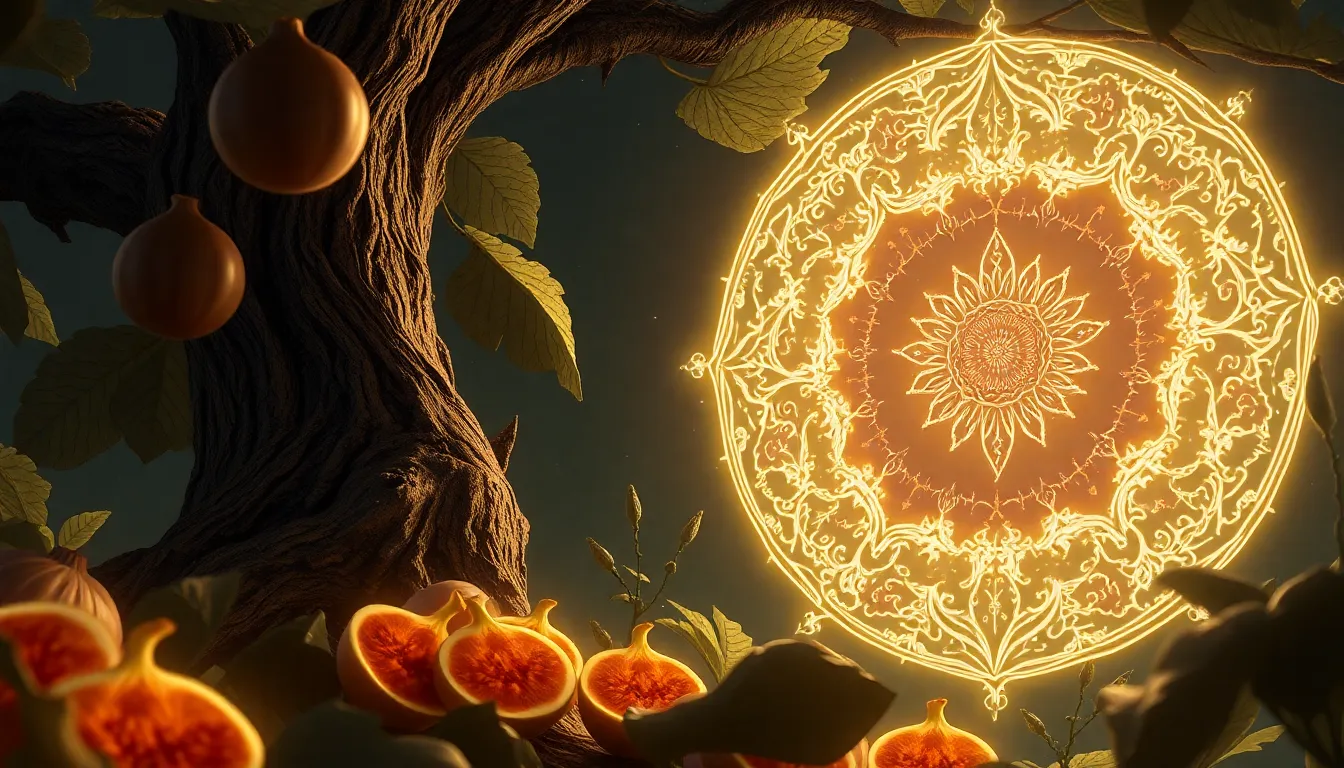The Myth of the Sacred Fig: A Symbol of Fertility and Abundance
I. Introduction
The Sacred Fig, scientifically known as Ficus religiosa, holds a revered place across various cultures and religions. This majestic tree, with its heart-shaped leaves and expansive canopy, is more than just a botanical specimen; it is a symbol steeped in myth, spirituality, and history. This article aims to explore the various myths, symbolism, and cultural significance surrounding the Sacred Fig, shedding light on its role as a powerful emblem of fertility and abundance.
II. Historical Context of the Sacred Fig
A. Origins and botanical characteristics
The Sacred Fig is native to the Indian subcontinent and is characterized by its large, glossy leaves that often have a distinctive tapering tip. This tree can reach heights of up to 30 meters, providing shade and shelter to various forms of life. Its roots are known to grow aerially, creating a breathtaking visual spectacle.
B. Historical significance in ancient civilizations
Historically, the Sacred Fig has been integral to various ancient civilizations. It is believed that the tree was first cultivated in India and later spread across Asia. The fig’s resilience and ability to thrive in diverse climates made it a staple in many cultures.
C. The Sacred Fig in religious texts and traditions
In religious texts, the Sacred Fig is often mentioned as a sacred entity. For instance, in Hinduism, it is associated with the gods and is often found in temples. In Buddhism, it is famously linked to the story of Siddhartha Gautama, who attained enlightenment while meditating under a Sacred Fig tree.
III. The Symbolism of the Sacred Fig
A. Fertility: Myths and interpretations
The Sacred Fig is widely regarded as a symbol of fertility. In many cultures, the tree is believed to bring blessings of fertility to couples and abundance to households. Myths surrounding the fig often involve divine intervention where offerings made to the tree yield bountiful harvests and healthy offspring.
B. Abundance: How the fig represents prosperity
Abundance is another key aspect of the Sacred Fig’s symbolism. The tree is often seen as a harbinger of prosperity, with its fruits representing the rewards of hard work and dedication. In agricultural societies, the health of the Sacred Fig tree often reflected the community’s overall well-being.
C. Connection to the cycle of life and death
The Sacred Fig also embodies the cyclical nature of life and death. Its shedding of leaves in the fall symbolizes the end of a cycle, while the new growth in spring represents rebirth and renewal. This duality is a poignant reminder of the interconnectedness of life.
IV. Cultural Representations of the Sacred Fig
A. The Sacred Fig in Hinduism and Buddhism
In Hindu culture, the Sacred Fig is often worshipped as a sacred tree, representing various deities. In Buddhism, the tree is revered as the Bodhi tree, under which Siddhartha Gautama achieved enlightenment. This connection has made the Sacred Fig a central symbol in both religions, often depicted in art and literature.
B. Folklore and myths surrounding the Sacred Fig in different cultures
Folklore surrounding the Sacred Fig varies across cultures. For example, in some African traditions, the tree is seen as a protector of the community and is often planted near homes. In other cultures, it is believed that spirits reside within the tree, making it a site for rituals and offerings.
C. Art and literature: Depictions of the Sacred Fig
- In art, the Sacred Fig is often depicted as a symbol of peace and tranquility.
- Literary references to the Sacred Fig abound, often symbolizing hope, growth, and spiritual awakening.
- Many contemporary artists draw inspiration from the Sacred Fig, using it to explore themes of nature and spirituality.
V. The Sacred Fig in Modern Spiritual Practices
A. Contemporary interpretations of the Sacred Fig’s symbolism
Today, the Sacred Fig continues to inspire modern spiritual practices. It is often viewed as a source of wisdom and guidance, reminding individuals of their connection to the earth and the cycles of nature.
B. Rituals and practices that honor the Sacred Fig
Various rituals are performed to honor the Sacred Fig, including:
- Planting fig trees during important life events.
- Creating offerings of fruits and flowers at the base of the tree.
- Gathering in community to celebrate the tree’s significance during festivals.
C. The role of the Sacred Fig in meditation and mindfulness
In meditation practices, the Sacred Fig serves as a focal point for mindfulness, encouraging individuals to reflect on their lives and the world around them. The tree’s calming presence is often used to promote inner peace and spiritual growth.
VI. Ecological and Economic Importance of the Sacred Fig
A. The role of the Sacred Fig in local ecosystems
The Sacred Fig plays a vital role in local ecosystems, providing habitat and food for various species. Its fruits are a source of nourishment for birds and other wildlife, contributing to biodiversity.
B. Economic importance: Uses of the Sacred Fig in agriculture and commerce
Economically, the Sacred Fig is valuable for its fruits, which are consumed and sold in many markets. Additionally, its wood is used in construction and crafting, making it an important resource for local communities.
C. Conservation efforts for Sacred Fig trees
Conservation efforts are underway to protect Sacred Fig trees, which are threatened by urbanization and deforestation. Initiatives include reforestation projects and community awareness campaigns highlighting the tree’s ecological importance.
VII. Critiques and Misunderstandings of the Sacred Fig Myth
A. Common misconceptions about the Sacred Fig’s symbolism
Despite its rich history, there are several misconceptions about the Sacred Fig. Some view it merely as a decorative plant, overlooking its spiritual and ecological significance. Others may misinterpret its symbolism, reducing it to mere superstition.
B. Debates among scholars and practitioners
Scholarly debates often arise regarding the interpretations of the Sacred Fig’s symbolism. Different cultural perspectives can lead to varying understandings, highlighting the need for a more nuanced approach to its mythology.
C. The impact of globalization on the Sacred Fig myth
Globalization has altered perceptions of the Sacred Fig, sometimes leading to its commodification. While this brings awareness, it can dilute the deeper spiritual meanings associated with the tree.
VIII. The Sacred Fig in Comparative Mythology
A. Similar symbols in other cultures (e.g., the olive tree, the pomegranate)
Comparative mythology reveals that many cultures have symbols akin to the Sacred Fig. The olive tree represents peace and prosperity in Mediterranean cultures, while the pomegranate signifies fertility and abundance in various traditions.
B. Cross-cultural analysis of fertility and abundance symbols
Examining these symbols across cultures highlights universal themes of fertility and abundance, showing how different societies interpret similar concepts through their unique lenses.
C. Lessons learned from comparative mythology
By studying these symbols, we learn about shared human experiences and the importance of nature in our spiritual lives. It emphasizes the interconnectedness of cultures and the enduring significance of nature’s symbols.
IX. Personal Reflections: The Sacred Fig in Today’s Context
A. The relevance of the Sacred Fig myth in contemporary society
In today’s fast-paced world, the Sacred Fig myth serves as a reminder of the importance of connection—to nature, to our communities, and to ourselves. It encourages mindfulness and reverence for the environment.
B. Personal anecdotes and stories related to the Sacred Fig
Many individuals share stories of their encounters with Sacred Fig trees, often recounting moments of clarity and peace experienced in their shade. These personal stories reflect the tree’s profound impact on individual lives.
C. The importance of preserving cultural myths in modern times
Preserving cultural myths like that of the Sacred Fig is crucial. They offer insights into our history, values, and connections to the earth, reminding us of the beauty and complexity of life.
X. Conclusion
A. Summary of key points discussed
Throughout this exploration, we’ve



